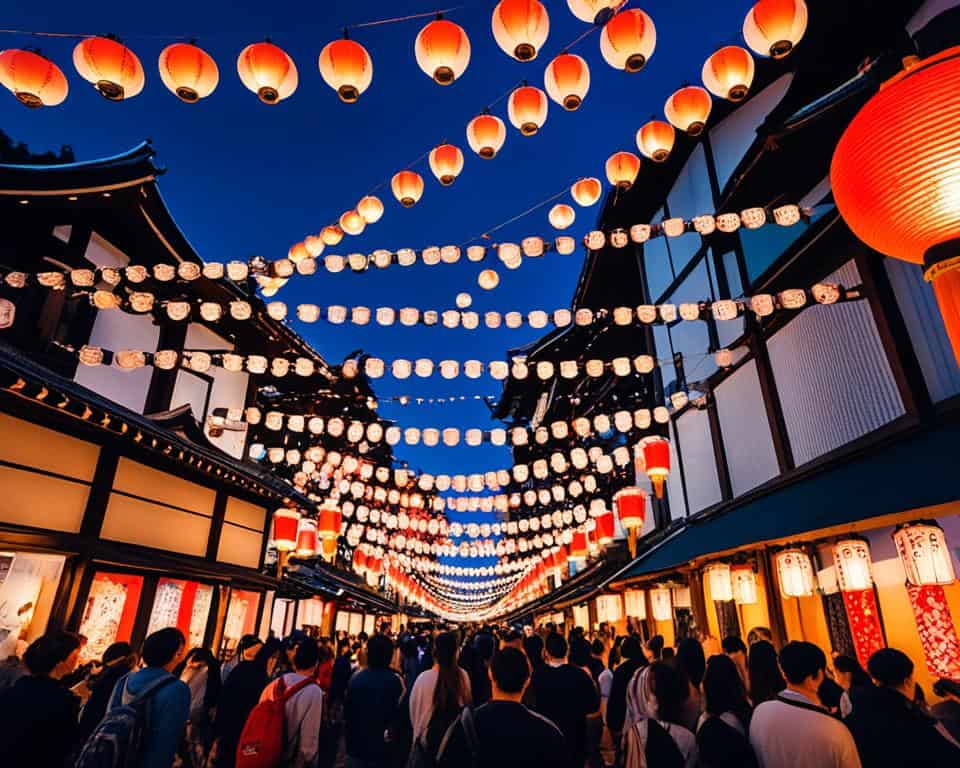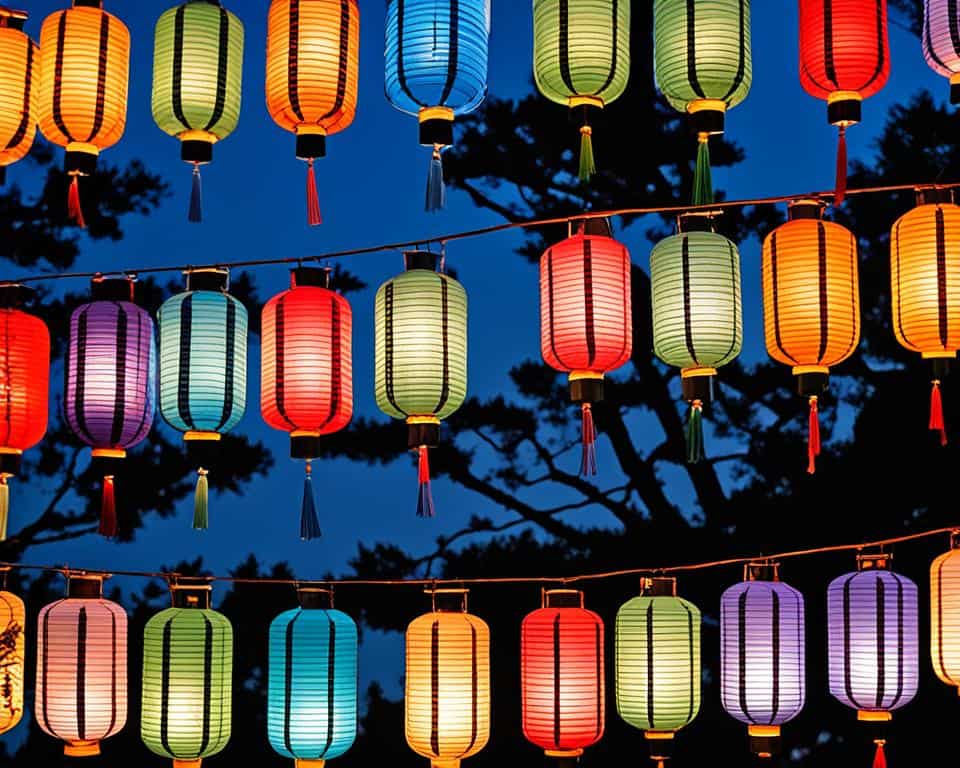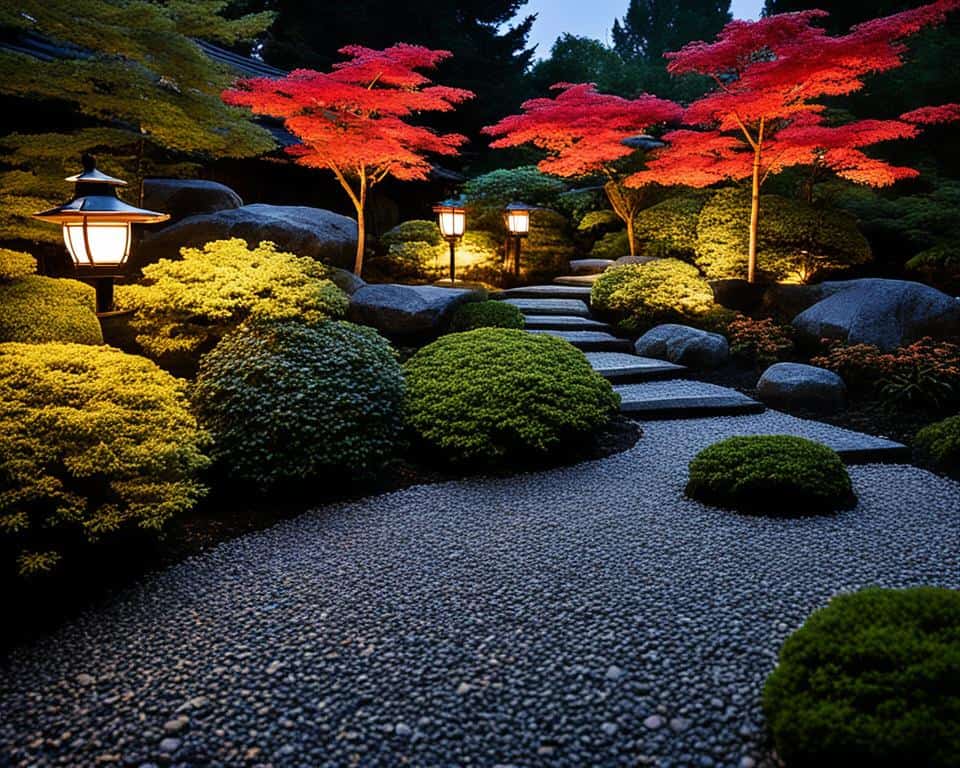
Walk through Japan’s lantern-lit streets and you’ll feel wrapped in an ancient tradition. The Japanese lantern isn’t just a source of light. It’s a cultural story-teller, linking past to present. Artisans shaped tales of joy on bamboo and washi paper. These traditional lanterns lit up festivals and home corners with grace.
In a Japanese garden lantern‘s gentle glow, echoes of the past play. The dance of shadows and light from paper lanterns shows the deep Japanese lantern design. This design speaks of skilled craftsmanship honed over years. The term Asian lantern hardly sums up the quiet pride each traditional Japanese lantern carries. They represent a blend of heritage and beauty unique to Japan.
The story of these lanterns began with their journey from China, becoming symbols of joy. They light the way not just physically, but through Japan’s story too. As time moves, their steady glow remains. This glow has seen empires change but never wavers, lighting tradition’s path through change.
Key Takeaways
- Discover how the Japanese lantern has transcended its pragmatic roots to become a revered emblem of culture.
- Uncover the ingenuity behind the foldable design that emerged during the Muromachi period and transformed utility into art.
- Explore the pivotal role paper lanterns played during the Edo period when they were essential sources of light.
- Learn how the Japanese garden lantern not only illuminates outdoor spaces but also symbolizes inner peace and contemplation.
- Witness the modern evolution of these cultural icons, which now integrate electric bulbs while retaining their traditional charm.
The Enchanting History of Japanese Lanterns
The journey through the Japanese lantern history is as illuminating as the lanterns themselves. Originating and becoming essential to Japanese culture, these lights show Japan’s ingenuity and cultural depth. They evolved to have great cultural significance.
From Chinese Origins to Japanese Cultural Icons
First coming from China, Japanese lanterns became more than light sources. They turned into cherished cultural icons. Exploring their history shows they were more than just lights. They became part of Japan’s social and religious life, turning into symbols of spirit and beauty.
Foldable Innovations during the Muromachi Period
The Muromachi period brought foldable paper lanterns. These were a big step forward. Crafted by Japanese artisans to collapse, their utility and ease of use skyrocketed. This move showed Japanese culture‘s adaptability, making lanterns widespread.
Edo Period: Lanterns as Everyday Essentials
In the Edo period, ceremonial lanterns turned into everyday needs. Candles became widespread, making these lights affordable and common. They moved from being luxury items to necessary in every home. This shows their lasting role in society.
Learning about lantern history shows the evolution of Japanese societal norms and practices. These lights don’t just light paths. They brighten our understanding of Japan’s history and cultural growth.
The Artistic Diversity of Japanese Lanterns
Exploring Japanese lantern decor reveals a wide array of styles. Each has its own history and beauty. You’ll find serene stone toro in gardens to vibrant chochin at festivals, and elegant andon illuminating interiors. Their artistic diversity is as vast as it is captivating.
Stone Toro: From Buddhist Temples to Modern Settings
Stone toro lanterns began in Buddhist temples. They helped guide both spiritual and physical paths. Now, they grace Shinto shrines and private gardens worldwide. These lanterns, often made of granite, bring a sense of peace and history. In traditional tea gardens, they are key for their light and as part of Asian lantern aesthetics and spiritual symbolism.
Chochin: The Evolution from Luxury to Ubiquity
Chochin lanterns are known for their bamboo frames and paper. They went from luxury items to everyday essentials. Once for the wealthy, they became popular for their affordability and portability. Great for festivals and lighting up shopfronts, their colorful exteriors are both advertising and celebratory. They echo a long tradition and community spirit.
Andon: The Elegance of Japanese Indoor Lighting
The andon adds a calm, elegant touch to Japanese lantern decor. Its traditional design includes paper on a wooden or bamboo frame. While it serves modern needs, it retains its classic beauty. Andon light up geishas and artisans alike. Nowadays, they also add style to homes, mixing old-world charm with modern spaces.

Japanese lanterns are more than just lights. They bring historical context, artistic decor, and beauty to places. Stone toro adds sculpted allure to gardens. Chochin brings festive brightness to parties. Andon offers quiet charm to rooms. Together, they light up our spaces and lives with both literal and cultural glow.
Japanese Lanterns in Contemporary Culture and Decor
Exploring Japanese lantern decor shows how they’ve gone beyond old uses. They’re now key in modern life and style. The beauty of Japanese lantern festivals lights up cities. They mix old traditions with new looks.
Japanese garden lanterns and trendy spots use these decorative lanterns. They’re more than just light sources. They stand for a mix of culture and today’s appeal. The charm of paper lanterns is loved by designers. They add an Asian feel to city places.
- They bring a calm feel to small garden spots.
- Their bold colors and designs light up modern areas.
- They make walkways and doors feel welcoming.
These lights are more than old objects. They join in on worldwide design and art talks. Adding them to your space or events mixes old and new. Each lantern’s light is a mix of tradition and today. It lights up the future with past lessons.
Celebrating with Light: Japanese Lantern Festivals
Experience the magic of Japanese lantern festivals at night. They showcase tradition and culture through light. Events like the Nagasaki Lantern Festival and Dai-Chochin Matsuri in Mikawa Isshiki bring people together. They honor ancestors and highlight Japanese culture’s beauty.
The Dazzling Nagasaki Lantern Festival
At Lunar New Year, Nagasaki turns into a light and color feast. It’s all thanks to the Nagasaki Lantern Festival. The city glows with over 15,000 lanterns, mixing Japanese and Chinese cultures. Streets come alive with dragon dances, parades, and music, attracting visitors globally.
Mikawa Isshiki’s Dai-Chochin Matsuri
The Dai-Chochin Matsuri in Mikawa Isshiki is known for its huge chochin lanterns. These lanterns are not just beautiful. They carry stories and history, lighting up the night with old tales.
Obon Festival: Ancestral Spirits and Paper Lanterns
The Obon Festival is a time to remember and celebrate. As a key Japanese lantern festival, it honors ancestors with chochin light. The highlight is the Toro Nagashi, where lanterns float on rivers, offering tranquility and reflection.
It’s a moment of deep emotion and community. The Bon Odori dance is a special part of it, connecting us to Japanese traditions.

These festivals show the heart of Japanese culture with light and shadow. They celebrate life, family, and history. You’ll find beauty in the lantern designs, the events’ meaning, or the joy of celebration. These lantern festivals let you experience Japan’s cultural richness.
How to Choose and Use Japanese Lanterns for Your Home
Adding Japanese lanterns for home decoration lights up your space and adds calm and elegance. You can choose from gentle paper lantern or sturdy Japanese garden lantern. Each kind improves the feel of your place. They add traditional and decorative lanterns. Here’s how to pick and use these lovely traditional lanterns. They bring a piece of Japan into your home.
- Determine the Purpose: Think about where you want to place the lanterns. Asian lanterns fit well in many home spots, from gardens to living rooms. A Japanese garden lantern fits outside, while a paper lantern makes indoors soft and warm.
- Choose the Style: There are many styles of Asian lanterns to choose from. You can pick from elegant hanging paper lanterns to grand stone garden lanterns. Pick something that matches your taste and Japanese decor.
- Installation: Setting up Japanese lanterns for home is usually easy. For paper and silk lanterns, make sure they hang securely. This is important if you use a real candle. For stone lanterns, placing them right in the garden makes them both pretty and useful.
- Lighting Options: Pick from classic candles to modern LED lights. LEDs last longer and are safer. They offer a cozy glow like a real candle but without the fire danger.
- Maintenance: Keeping paper lanterns clean is vital for them to last. Store them right when not used. For outdoor lanterns, make sure they can handle weather or cover them well.
By picking the right styles and keeping them well, Japanese lanterns can make your home a peaceful place. It’s more than just decor. It’s about making a space that shows harmony and peace every day.
Conclusion
The story of the Japanese lantern is rich with history. It shows the beautiful weave of Japanese culture. More than just providing light, these lanterns symbolize Japan’s history and aesthetics.
They add elegance to homes and excitement to festivals. This shows both the community’s unity and its joy.
The Asian lantern bridges past and present in a lovely way. It’s not just for show. It lights up Japanese gardens and city events, showing love for tradition and modern ways.
Your grasp of these items grows by seeing their role in Japan’s culture. A lantern’s light reflects the nation’s history and people’s spirit.
Japanese lanterns are cherished in Asian arts. They enchant those who love Japanese culture, fine craftsmanship, or beauty. Exploring these lanterns’ story can enhance your respect for Japan’s balance of history and progress.
FAQ
What is the historical significance of Japanese lanterns?
Japanese lanterns came from China a long time ago. They were made of bamboo and paper. Over time, they became key in Japanese culture. They were used in many events and as daily lights in the Edo period. Today, they bring beauty and tradition to celebrations in Japan.
How have Japanese lanterns evolved from traditional to modern times?
At first, Japanese lanterns were for special events. They became part of daily life and culture. Innovations made them easy to use. Now, they can have electric lights but still keep their traditional look. They decorate and light up festivals, blending old traditions with new uses.
What are some types of traditional Japanese lanterns?
There are many styles of traditional Japanese lanterns. Stone toro lanterns started in Buddhist temples. Now, you see them in gardens and shrines, bringing peace. Chochin lanterns are paper and can fold up. They decorate shops and festivals. Andon lanterns lit up homes beautifully. Each style shows Japanese lantern art.
Can Japanese lanterns be used for home decor and how?
Yes, Japanese lanterns are great for home decor. Put a bulb inside a paper lantern for a cozy light. Some can hold candles. Keep them safe when not used, and protect them from bugs. These lanterns add a touch of Japanese beauty to your home.
What are some renowned Japanese lantern festivals?
Japan has many famous lantern festivals. The Nagasaki Lantern Festival brightens the city with 15,000 lanterns. It has parades and dances. The Dai-Chochin Matsuri shows huge, lovely chochin lanterns. At the Obon Festival, lanterns float on rivers for ancestors. People also enjoy the Bon Odori dance.
Are Japanese lanterns still relevant in today’s society?
Definitely, Japanese lanterns are important today. They mix tradition with modern design in decor and events. These lanterns are symbols of Japanese culture. They show how to honor the past in today’s world.
How do I properly maintain a paper lantern?
Take care of paper lanterns gently. Fold them and keep them dry when not in use. Use a soft cloth for dust. Don’t use water or strong cleaners. A non-toxic repellent can prevent bug damage. Always follow the maker’s care advice.

[…] One of the most striking features of Japanese Maple trees is their foliage. The leaves of these trees are intricately shaped, with deeply cut lobes that resemble delicate lacework. The leaves come in a variety of colors, ranging from vibrant reds and oranges to soft pinks and purples. Each leaf is a work of art, adding a touch of elegance to any landscape. […]